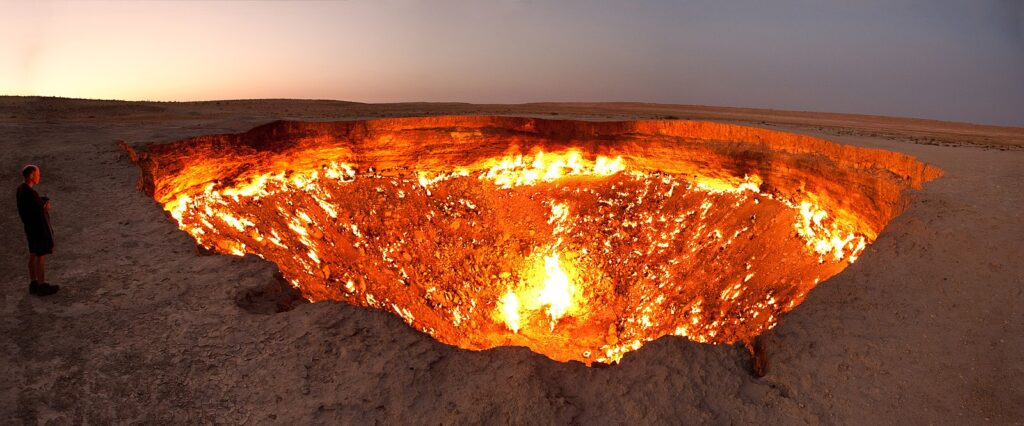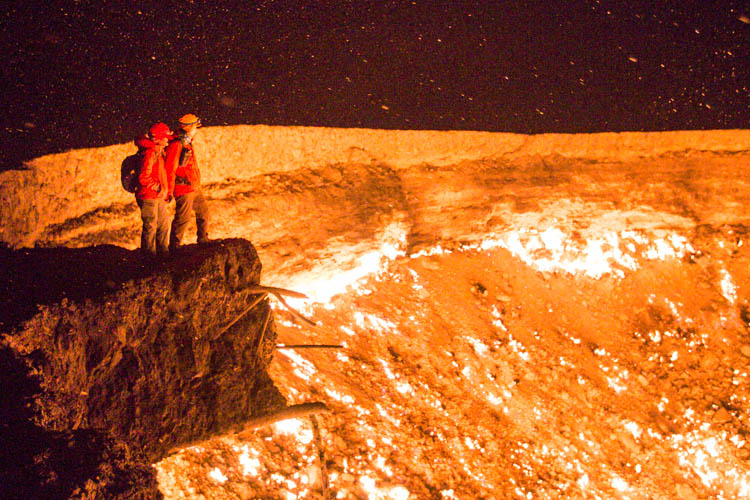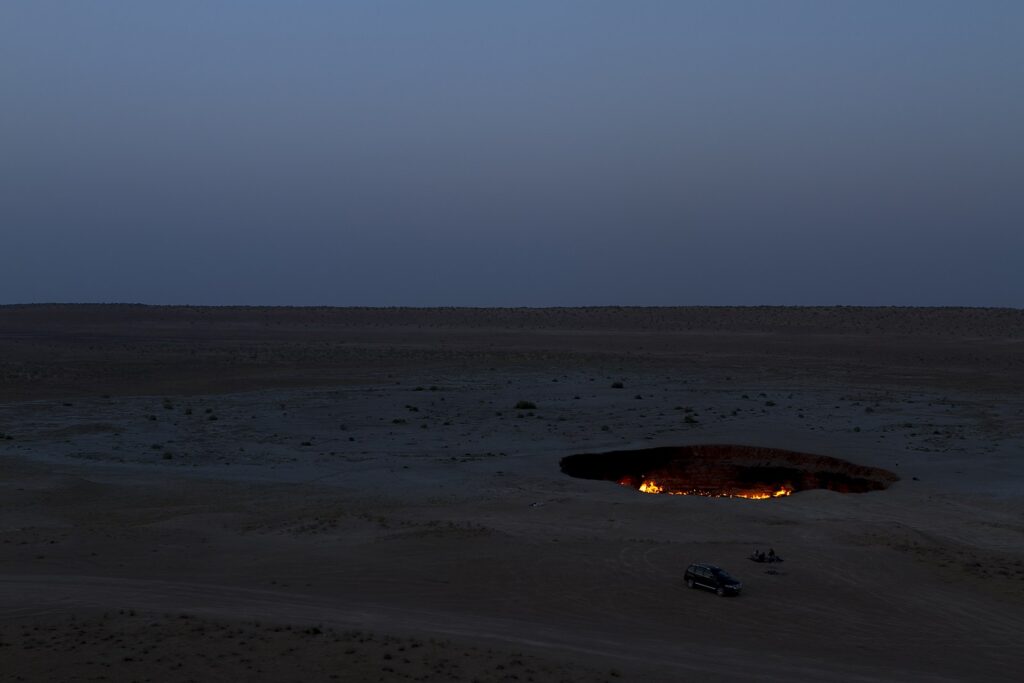It is not uncommon for fires to occur underground. In fact, they are a global phenomenon, from Pennsylvania to Germany to China.
The most common form of underground fire is a coal seam fire, where large underground deposits of coal catch flame. With such a large fuel source, endless oxygen, and a massive price tag on any attempt to extinguish them, these kinds of fires rage for years, decades, and even centuries.
Sometimes other flammable natural materials catch fire though. There are also commonly large deposits of natural gas located around the world.
Due to the toxic nature of natural gas to humans, it is not uncommon for people to intentionally set natural gas deposits on fire in an attempt to burn off the gas. This generally burns through its supply faster than a coal seam.
Unlike coal though, it is nearly impossible to determine how much natural gas is actually present beneath the earth. Therefore, lighting a natural gas supply is always a gamble.
This practice is what caused one of the most notable continuously burning fires in the world: the Darvaza gas crater.

A Burning Pit
The Darvaza gas crater, located in the Karakum Desert in Turkmenistan, is 229 feet (70m) across. It is 65 feet (20m) deep, and filled with fire.
Flames leap out from every nook and cranny in the rock all around the pit as natural gas slips through. It ignites from the existing fire and the collective flames create a roar equivalent to a jet engine.
Also known as the “Gates of Hell” because of the sheer size of the ever-burning flames, the pit has been alight for over 50 years. It has become a globally recognized spectacle and a tourist destination, bringing hundreds a year to Turkmenistan to see the pit.
Since the pit is in the desert, there is not much around besides a few small towns. But some locals have taken advantage of the rare tourism and set up yurts around the rim of the pit for travelers to stay overnight in.
These are used regularly by guests, especially since the scene is much more striking in the dead of night.
Origin of the Crater
It is unclear how the crater itself was formed, as there are no recorded documents or eyewitness accounts of its inception. There are two main theories though, debated between popular lore and the hypotheses of local geologists.

The most common explanation for the crater is that it is the site of a 1970s Soviet drilling collapse. As workers dug they realized they hit an underground cavern. They fled the scene as the ground began to give way beneath them, swallowing up their equipment.
Then, to prevent the flow of toxic gasses to the surrounding area, the engineers set the crater ablaze. They underestimated how long it would burn.
Geologists, on the other hand, believe that the crater was discovered in the 1960s. However, they believe that it was not ignited until the 1980s in a similar attempt to cut off the natural gas from leaking to the surrounding community.
Attempts to Put Out the Flames
In the last decade, Gurbanguly Berdymukhamedov, the president of Turkmenistan, has begun making efforts to extinguish the fire. In 2010 he asked scientists to find a way to extinguish the flames.
He is hopeful that it could minimize the impact of the pit on further development of gas mining in the region. However, it is nearly impossible to put out a fire this size fueled by natural gas. Even if the entire pit was filled or extinguished, the gas would only need to find another hole to escape from to become ignited again.
In 2022, Berdymukhamedov reasserted his desire to extinguish the pit. He cited the environmental impact of the pit and the health impact on local communities.
The burning of the gas is constantly releasing methane into the atmosphere. The nearby town of Darvaza (or Derweze) is close enough for the noxious fumes to affect the population.
Alongside the altruistic goals is Berdymukhamedov’s assertion that the pit is also wasting natural resources. Resources that could be used to further the economic goals of the nation.
By ending the constant burning of gas, the nation could instead start to harvest the natural gas for fuel and improve the country with the profit. Turkmenistan is known to have the fourth-largest reserve of natural gas in the world.

Investigating the Flames
In 2013, George Kourounis was the first person to descend into the pit to investigate the microbiome of the crater. With a special suit made of kevlar that included a unique breathing apparatus, Kourounis descended to the bottom of the pit.
As he dug into the dirt to gather soil samples, new flames began to immediately appear. Even the smallest new dent in the crater immediately provided the gas with a new path to emerge from the earth and ignited the gas from the inferno around it.
The adventure was sponsored by National Geographic and Kourounis’ findings were shared in an episode of the series Die Trying.
It seems that the Darvaza gas crater will continue to burn for the foreseeable future. After half a century, the flames have shown no sign of slowing. Without intervention, there is no telling how long it will burn or how much gas remains trapped underground.
Despite the best attempts by the president, it seems unlikely that Turkmenistan will be able to quell the fire anytime soon. So for now, the site will remain an obscure attraction to those willing to travel to the remote desert and witness the Gates to Hell themselves.
References
Recker, Jane. “The Quest to Extinguish the Flames of Turkmenistan’s Terrifying ‘Gates of Hell’ Firepit.” Smithsonian Magazine, January 25. 2022. https://www.smithsonianmag.com/smart-news/the-quest-to-extinguish-the-flames-of-turkmenistans-terrifying-gates-of-hell-firepit-180979458/.
“Turkmenistan plans to extinguish vast gas crater fire dubbed ‘Gateway to hell’” The Guardian, January 8, 2022. https://www.theguardian.com/world/2022/jan/08/turkmenistan-plans-to-extinguish-vast-gas-crater-fire-dubbed-gateway-to-hell.
King, Hobart M. “Darvaza Gas Crater.” Geology.com. https://geology.com/oil-and-gas/darvaza-gas-crater/.


I’ve watched a few documentaries about the crater, and one thing that stuck with me is how silent the surrounding desert is compared to the roaring fire. It’s almost like the crater has its own atmosphere. That contrast between total calmness and this fiery chaos in the center makes it feel even more otherworldly.